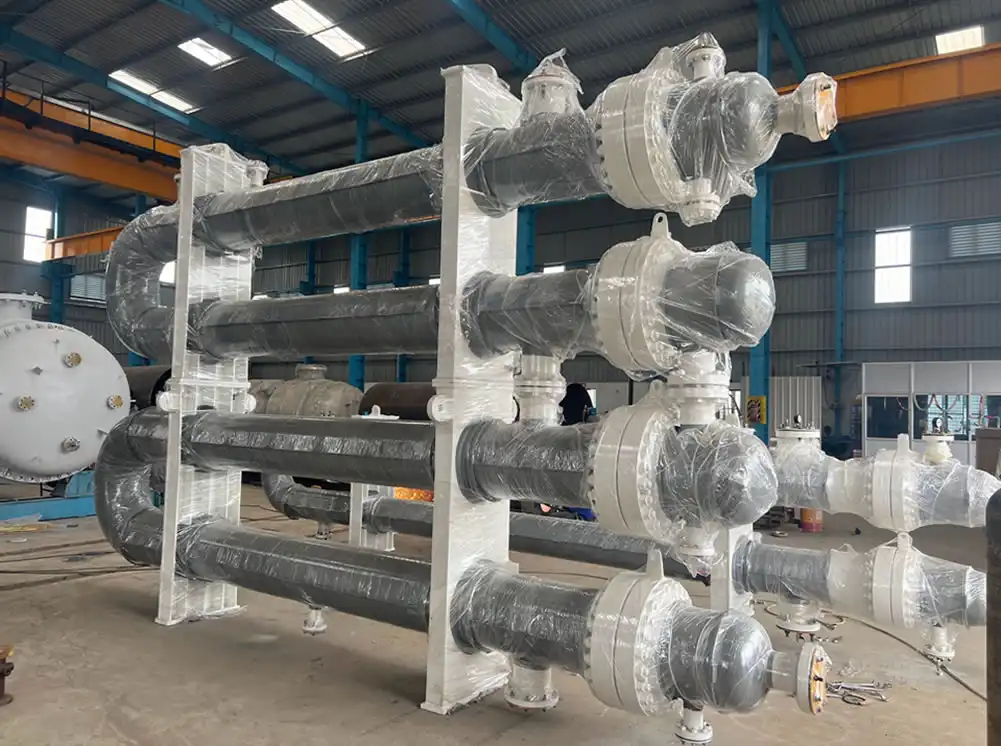Introduction
Space saving heat exchangers is a compact, highly efficient thermal device engineered to transfer heat between two different fluids while occupying minimal installation space. Unlike traditional bulky heat exchangers, these are designed for tight, confined environments without compromising performance. Thanks to their high heat transfer coefficients and enhanced surface designs, they manage to deliver maximum thermal exchange within compact dimensions. Industries like marine, oil & gas, HVAC, chemical processing, food & beverage, and pharmaceuticals often rely on these units where equipment room is scarce.
Key Feaures
Compact Design
The defining characteristic of space-saving heat exchangers is their optimized surface-area-to-volume ratio.
- In a conventional heat exchanger, size is directly proportional to capacity. But space-saving designs cleverly increase the number of heat transfer surfaces within the same physical space by using stacked plates, spiraled tubes, or multi-pass configurations.
- Example: A plate heat exchanger can offer the same capacity as a shell and tube model 5–10 times its size by stacking multiple thin plates with narrow gaps.
Lightweight Construction
Many space-saving exchangers utilize lightweight, corrosion-resistant materials like:
- Stainless Steel (SS 304, 316)
- Titanium (for seawater and aggressive chemicals)
- Aluminium alloys (for HVAC and lightweight industrial skids)
This keeps the weight low without sacrificing durability, making them easier to install in locations like overhead pipelines, ship engine rooms, offshore rigs, and containerized process units.
Multiple Configurations to Suit Various Needs
Space-saving heat exchangers are available in several designs:
- Plate Heat Exchangers (PHE): Modular, compact, and efficient; ideal for HVAC, industrial cooling, and hygienic applications.
- Spiral Heat Exchangers: Coiled channels for excellent thermal performance with a small footprint; perfect for sludge-heavy or fouling applications.
- Double-Pipe Heat Exchangers: Simple, compact, and easily expandable for small-scale industrial systems.
- Compact Shell & Tube Models: Designed with reduced shell diameter and multiple tube passes to save length and space.
Advantages
Maximizes Available Floor Space
In industrial facilities, available floor and wall space is a premium. Installing bulky equipment reduces flexibility and can complicate maintenance access.
Compact heat exchangers enable engineers to:
- Fit essential cooling/heating systems in small equipment rooms.
- Mount exchangers on walls, platforms, or within enclosed cabinets.
- Integrate systems vertically or horizontally without layout conflicts.
Lower Installation & Structural Costs
Since these units require less floor space and weigh significantly less:
- Foundation costs are reduced.
- Pipe routing becomes simpler as units can be placed nearer to their heat sources or sinks.
- Often, standard brackets or supports are enough for mounting, avoiding heavy-duty platforms.
Simplified System Integration
Space-saving exchangers can be directly integrated into:
- Modular systems or skid-mounted process units.
- Retrofitted into existing plants without needing extensive civil or structural modifications.
- Easily added into tight pipelines for processes like hydraulic oil cooling, intercooling, or pasteurization.
This makes them ideal for system upgrades, capacity expansions, and decentralized cooling systems.
Easy Access for Cleaning & Servicing
A frequent concern in compact systems is ease of maintenance. Thankfully, most space-saving designs offer:
- Removable plates, covers, or tube bundles.
- Quick-release fasteners or hinged access panels.
- Clean-in-Place (CIP) systems especially for food, beverage, and pharmaceutical processes.
This minimizes downtime and simplifies inspections in industries requiring stringent hygiene and operational reliability.
Common Applications
Skid-Mounted Industrial Cooling Systems
In portable or containerized industrial systems, every square meter is valuable. Space-saving heat exchangers handle oil cooling, hydraulic fluid cooling, and jacket water cooling in confined environments like:
- Power generation skids
- Portable chillers
- Mobile chemical dosing plants
Marine Engine Cooling
Marine vessels have very limited engine room space. Compact heat exchangers are used for:
- Engine jacket water cooling
- Gear oil cooling
- Turbocharger intercooling
- Air conditioning systems on ships and offshore rigs
HVAC Systems in Commercial Buildings
In hospitals, hotels, multiplexes, and office towers, compact plate heat exchangers handle:
- Chilled water circuits
- Heat recovery systems
- Domestic hot water generation
Their small size allows installation in mechanical floors, basements, or service ducts without wasting rentable space.
Food & Beverage Processing
Clean, compact, and easy-to-maintain heat exchangers are vital in:
- Pasteurization units
- Milk & beverage cooling
- CIP heating/cooling circuits
- Brewery applications
They maintain hygienic standards while occupying minimal space within cleanrooms and production floors.
Pharmaceutical Compact Plants
In modular pharmaceutical units, where strict cleanliness and compactness are mandatory:
- Space-saving heat exchangers handle process heating and cooling.
- Easily installed in cleanrooms, HVAC ducts, or skid packages.
- Compatible with steam, chilled water, glycol, or process fluids.
Conclusion
Space saving heat exchangers are not just a modern convenience but a necessity for today’s compact, high-density industrial systems. As industries shift towards modular, mobile, and integrated plant designs, these exchangers offer a perfect balance of performance, flexibility, ease of maintenance, and minimal space consumption. Their adaptability across various types and configurations ensures they remain a preferred solution in both new installations and retrofit applications.

